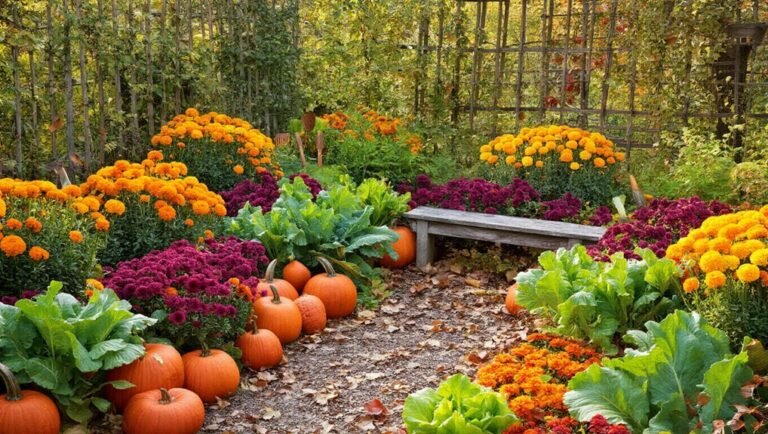To create a thriving autumn garden, start by choosing hardy annuals and perennials suited for cooler temperatures. Prepare your soil by clearing debris and enriching it with compost. Extend your growing season using cloches and row covers to protect plants from the cold. Implement companion planting for natural pest control and utilize mulch to retain moisture. Don’t forget to plan for winter with cover crops that enrich the soil. There’s more to uncover about maximizing your fall garden’s potential.
Key Takeaways
- Select cool-season hardy annuals like pansies and snapdragons, and incorporate perennials for lasting autumn beauty.
- Prepare soil by clearing debris, loosening it, and enriching with compost for optimal plant growth.
- Use cloches and row covers to protect plants from cold and extend the growing season.
- Implement companion planting, such as marigolds with tomatoes, to naturally deter pests and enhance growth.
- Create a weekly maintenance schedule to monitor plant health, adjust watering, and schedule timely harvesting.
Choose the Right Fall Plants for Your Garden
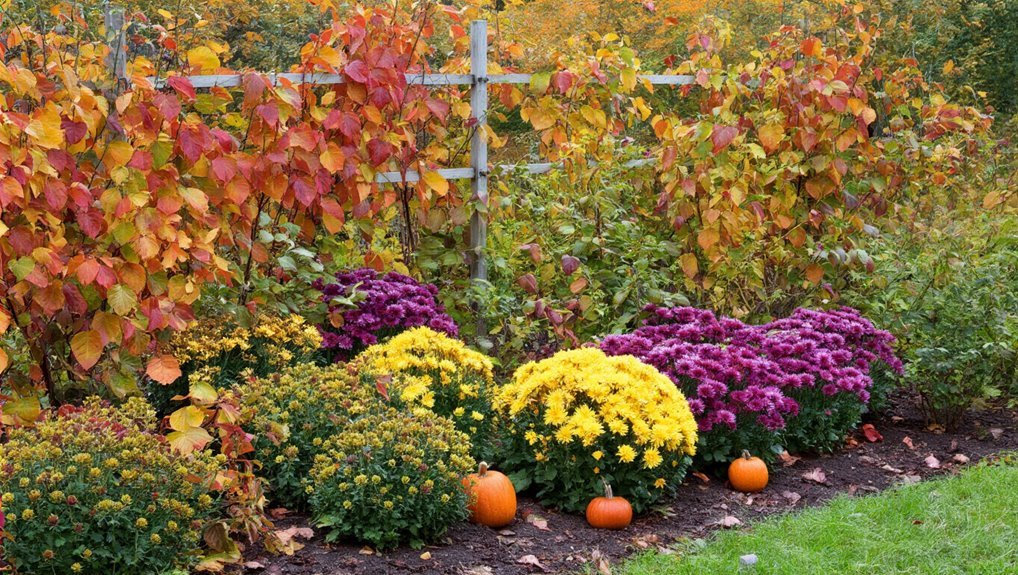
As the days grow shorter and the air turns crisp, choosing the right fall plants for your garden can make all the difference in creating a vibrant landscape.
Start by selecting hardy annuals like pansies and snapdragons, which can withstand cooler temperatures and provide a burst of color. Consider incorporating perennials such as asters and chrysanthemums for lasting beauty. Investing in seed starting kits can help you get a jumpstart on your fall planting by giving seeds the ideal environment to sprout and grow strong before transplanting.
Ornamental grasses, with their swaying plumes, add texture and movement to your garden. Don’t forget about vegetable options; kale, Brussels sprouts, and root vegetables thrive in fall.
When you choose plants that bloom in autumn or hold their color through winter, you’ll ensure your garden remains lively even as the seasons change.
For a creative and unique touch, try planting Edible Flower Seeds to add both beauty and flavor to your fall garden.
Enjoy the process, and watch your garden transform!
Prepare Your Soil for Autumn Planting
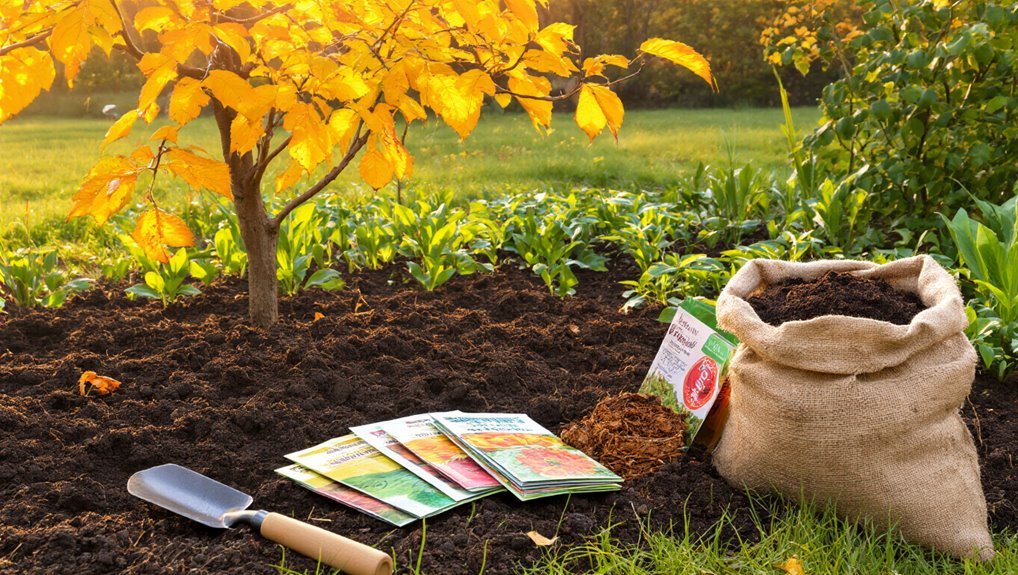
Preparing your soil for autumn planting is essential for a thriving garden. Start by clearing away any debris, dead plants, or weeds to create a clean canvas.
Next, loosen the soil using a garden fork or tiller; this improves aeration and drainage. Adding organic matter, such as compost or well-rotted manure, enriches the soil with nutrients and enhances its structure. Mulching with organic mulching materials like straw can further help conserve soil moisture and protect plant roots as the weather cools.
Test your soil’s pH, as many fall crops prefer slightly acidic to neutral conditions. If necessary, amend the soil with lime or sulfur to adjust the pH.
Finally, consider mulching to retain moisture and suppress weeds as temperatures drop. Using a compost bin can make it easy to create nutrient-rich compost right at home for your autumn garden beds.
With well-prepped soil, you’ll set the stage for a bountiful autumn harvest.
Happy planting!
Extend Your Growing Season With Cloches and Row Covers
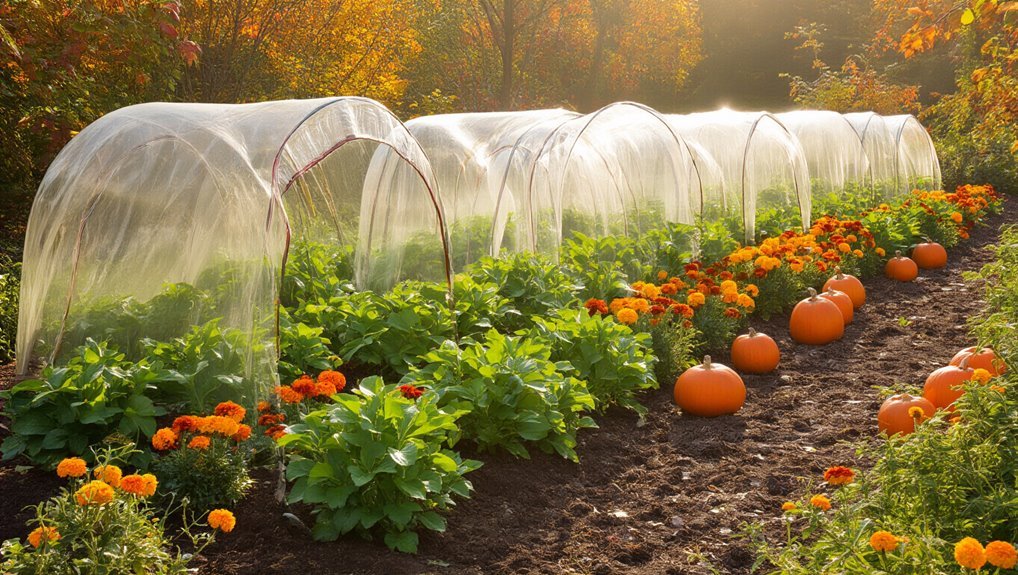
To keep your garden thriving well into the cooler months, using cloches and row covers can make a significant difference.
These protective coverings trap heat and create a microclimate around your plants, shielding them from frost and chilly winds. Cloches, which are often made from glass or plastic, are perfect for individual plants, allowing sunlight in while keeping temperatures up. For those looking for a versatile solution, portable greenhouses provide similar benefits by offering adaptable protection and mobility for various garden setups.
Row covers, on the other hand, can blanket entire rows, protecting your crops from harsh elements. Just remember to remove them during sunny days to prevent overheating.
Additionally, you can easily set them up for quick installation and removal, giving your plants the best chance to flourish as the season changes.
If you want a more permanent solution for extending your growing season, consider investing in mini and large greenhouses, which offer even greater protection and flexibility for your autumn garden.
Invest in these tools for a successful extended growing season!
Implement Companion Planting for Pest Control
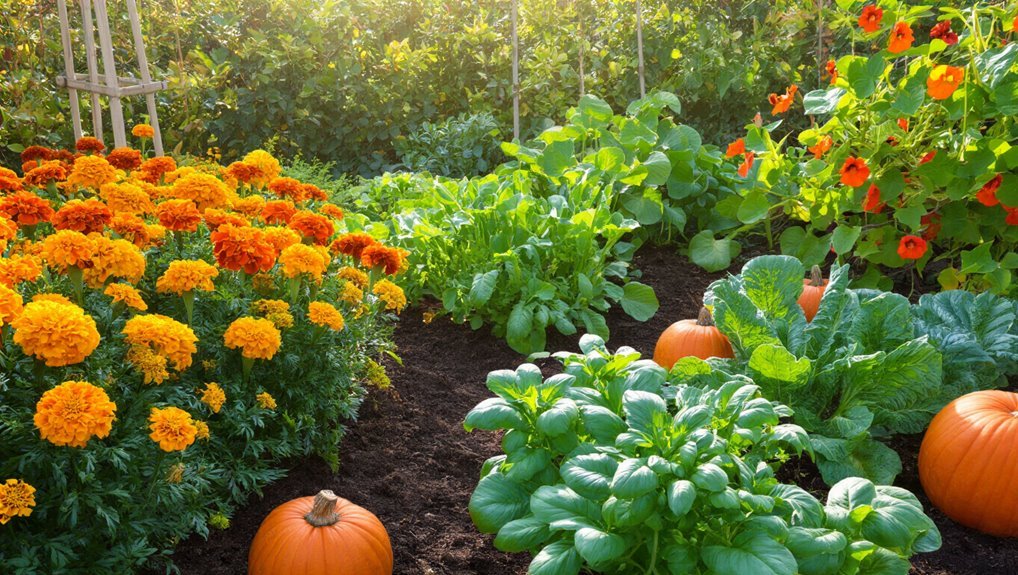
While protecting your plants from frost is important, keeping pests at bay is equally vital for a successful fall garden. One effective way to do this is through companion planting. By strategically placing plants together, you can deter pests naturally.
For instance, planting marigolds alongside vegetables like tomatoes can repel nematodes and aphids. Similarly, interplanting basil with peppers can enhance growth while keeping insect invaders away. You can also boost your pest management by using garden pest traps, which are a reliable way to monitor and control insect populations in your fall garden.
Consider pairing garlic with roses to fend off aphids, or using nasturtiums to attract beneficial insects that prey on pests.
When you mix and match plants, you create a healthier ecosystem in your garden. This method not only protects your crops but also promotes biodiversity, leading to a thriving autumn garden. You may also want to incorporate insect repellent plants such as citronella into your fall garden to further reduce unwanted pests naturally.
Utilize Mulching to Retain Moisture and Regulate Temperature
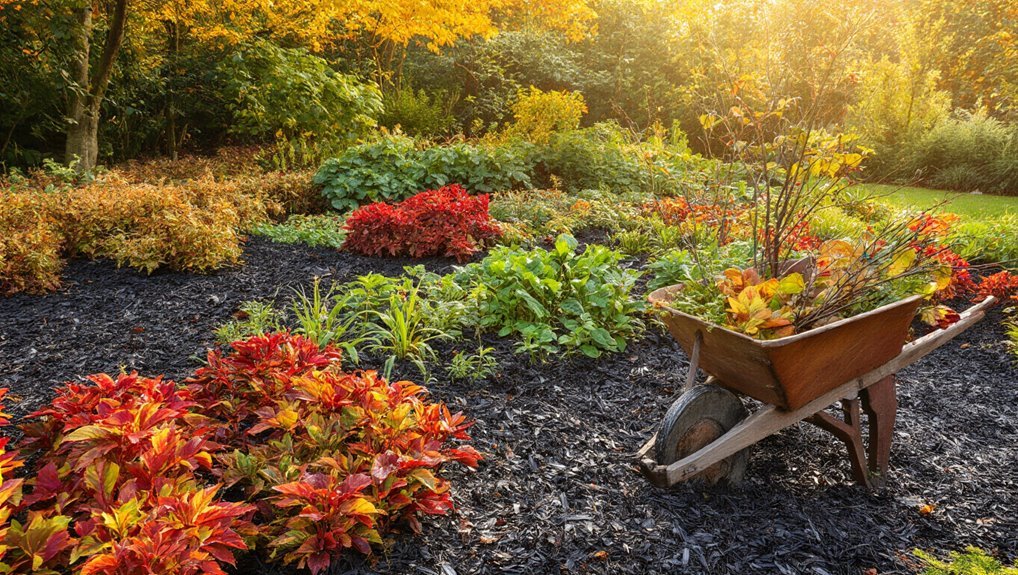
As the days grow shorter and temperatures begin to fluctuate, utilizing mulch can be a game changer for your fall garden. Mulch helps retain moisture and regulates soil temperature, creating a more stable environment for your plants. It’s especially crucial in fall, as plants prepare for winter. Applying mulch can provide long-lasting benefits to your garden by improving soil health and reducing maintenance needs. Choosing the right mulch is important, but pairing it with quality garden soil will give your plants the best foundation for growth all season long.
Here’s a quick comparison of mulch types:
| Mulch Type | Benefits | Best For |
|---|---|---|
| Straw | Insulates and retains moisture | Vegetable gardens |
| Wood Chips | Reduces weeds and improves soil | Flower beds |
| Leaves | Nutrient-rich and biodegradable | All garden types |
Plan for Winter With Cover Crops
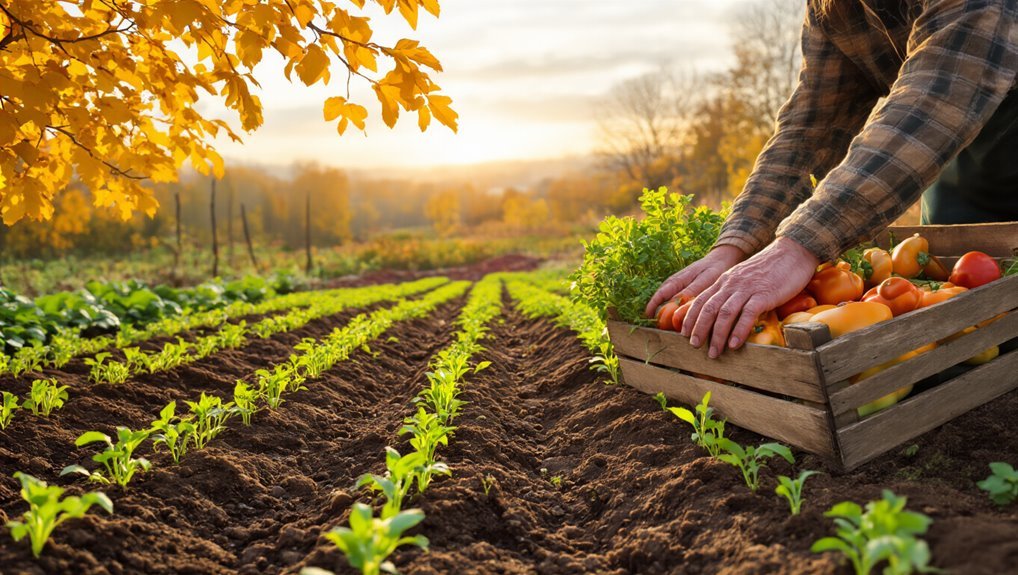
Cover crops can significantly enhance your garden’s health during the winter months, preventing soil erosion and improving nutrient levels. By planting these crops, like clover or rye, you’re not only protecting the soil but also enriching it for spring planting.
As they grow, cover crops absorb excess nutrients, reducing runoff and preventing leaching. Outdoor composting systems can work hand-in-hand with cover crops by providing additional organic matter to enrich your soil and support long-term fertility. In the spring, you can simply till them into the soil, returning vital organic matter and nutrients back to your garden.
Plus, they help suppress weeds, giving your future plants a head start. To succeed, choose varieties suitable for your climate and plant them before the first frost. This proactive step ensures your garden thrives when the growing season returns.
For even greater soil improvement, consider adding Compost Tumblers to your routine, as they provide a convenient way to create nutrient-rich compost that further boosts your garden’s fertility.
Create a Fall Garden Maintenance Schedule
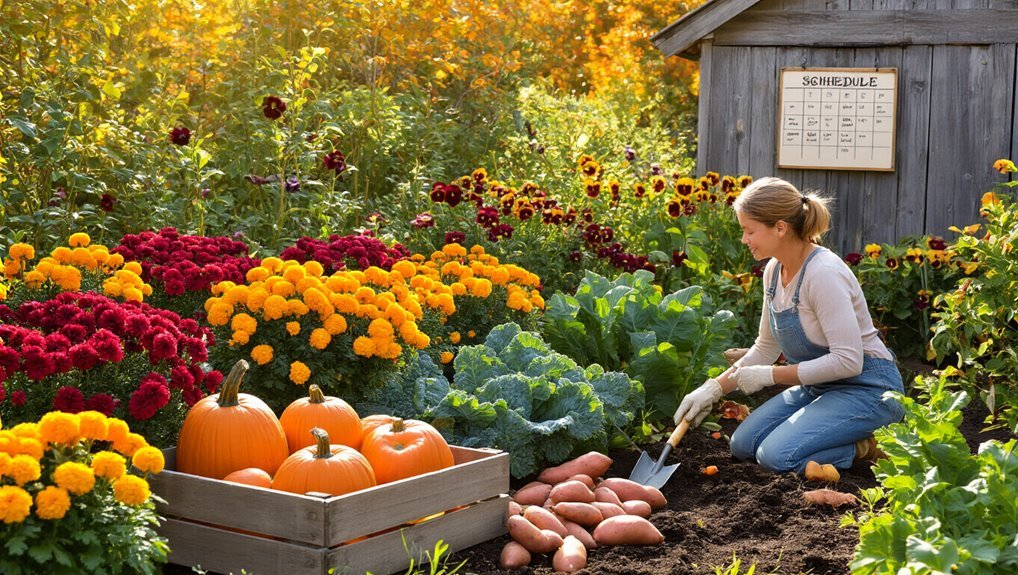
After planting cover crops to protect and enrich your soil, it’s time to focus on maintaining your garden as the weather cools.
Start by creating a weekly maintenance schedule to keep everything on track. Dedicate time each week to check on your plants, removing any weeds that may compete for nutrients. Monitoring compost temperature with a compost thermometer can help ensure your compost breaks down efficiently during the fall season.
Monitor soil moisture levels, especially as temperatures drop, and adjust your watering routine accordingly. Consider using soil moisture sensors to ensure your garden receives the right amount of water at all times, which is essential for plant health during the fall.
Plan for regular fertilization to support your crops through the cooler months.
Additionally, keep an eye out for pests and diseases, taking immediate action if you spot any issues.
Finally, schedule time for harvesting your fall crops, ensuring you enjoy the fruits of your labor before winter sets in.
Frequently Asked Questions
Can I Plant Bulbs in the Fall for Spring Blooms?
You might think it’s too late to plant bulbs, but fall is actually the perfect time! You can plant them now, and they’ll bloom beautifully in spring, bringing vibrant colors to your garden.
How Do I Protect My Garden From Early Frost?
To protect your garden from early frost, cover plants with burlap or frost cloth, mulch around roots to insulate, and bring potted plants indoors. You’ll ensure your plants stay warm and thrive despite chilly temperatures.
What Tools Are Essential for Fall Gardening?
You’ll need a sturdy rake for clearing leaves, a spade for digging, gloves to protect your hands, pruners for trimming, and a trowel for planting. These tools make your fall gardening tasks so much easier!
Are There Any Pests That Thrive in Fall Gardens?
As leaves swirl down like confetti, pests like aphids and spider mites often thrive in fall. They’ll sneak into your garden and feast on your plants, so stay vigilant and check your crops regularly.
How Can I Repurpose Summer Plants for Fall Gardening?
You can repurpose summer plants by trimming back their growth, dividing perennials, or using their soil to enrich fall crops. Consider planting cool-season vegetables in the same space for a productive autumn garden.
Conclusion
As you wrap up your autumn gardening adventures, remember that a little preparation goes a long way. Just like a knight sharpening their sword before battle, taking the time to choose the right plants and care for your soil will set you up for success. With these tips, your fall garden can thrive well into winter. So gear up, get your hands dirty, and enjoy the bounty that your hard work will bring!

